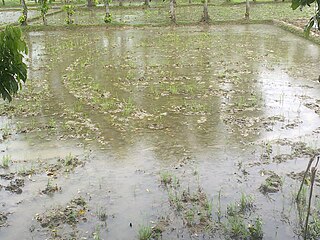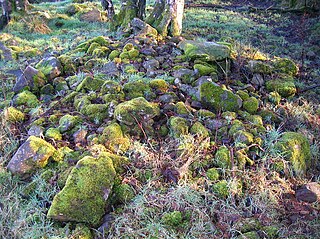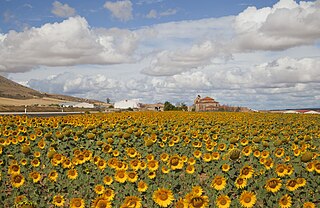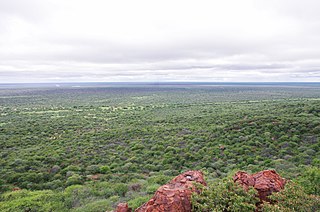 W
WAgricultural land is typically land devoted to agriculture, the systematic and controlled use of other forms of life—particularly the rearing of livestock and production of crops—to produce food for humans. It is generally synonymous with both farmland or cropland, as well as pasture or rangeland.
 W
WThe agricultural landscape of southern Öland is an area of more than 56,000 hectares located on the island of Öland, Sweden. It includes Stora alvaret, a limestone plateau of around half that surface. Stora alvaret is a dagger-shaped area almost 40 km (25 mi) long and about 10 km (6.2 mi) at its widest north end. This limestone plain, around a quarter of the surface of the island, is the most extended of its kind in Europe. As a result of the thin layer of soil and high pH levels, it presents a wide range of plants, including many rare species.
 W
WArable land is any land capable of being ploughed and used to grow crops. Alternatively, for the purposes of agricultural statistics, the term often has a more precise definition:Arable land is the land under temporary agricultural crops, temporary meadows for mowing or pasture, land under market and kitchen gardens and land temporarily fallow. The abandoned land resulting from shifting cultivation is not included in this category. Data for 'Arable land' are not meant to indicate the amount of land that is potentially cultivable.
 W
WUrine patches in cattle pastures generate large concentrations of the greenhouse gas nitrous oxide through nitrification and denitrification processes in urine-contaminated soils. Over the past few decades, the cattle population has increased more rapidly than the human population. Between the years 2000 and 2050, the cattle population is expected to increase from 1.5 billion to 2.6 billion. When large populations of cattle are packed into pastures, excessive amounts of urine soak into soils. This increases the rate at which nitrification and denitrification occur and produce nitrous oxide. Currently, nitrous oxide is one of the single most important ozone-depleting emissions and is expected to remain the largest throughout the 21st century.
 W
WA clearance cairn is an irregular and unstructured collection of fieldstones which have been removed from arable land or pasture to allow for more effective agriculture and collected into a usually low mound or cairn. Commonly of Bronze Age origins, these cairns may be part of a cairnfield where some cairns might be funerary. Clearance cairns are a worldwide phenomenon wherever organised agriculture has been practised.
 W
WIn agriculture, a field is an area of land, enclosed or otherwise, used for agricultural purposes such as cultivating crops or as a paddock or other enclosure for livestock. A field may also be an area left to lie fallow or as arable land.
 W
WGrasslands are areas where the vegetation is dominated by grasses (Poaceae). However, sedge (Cyperaceae) and rush (Juncaceae) can also be found along with variable proportions of legumes, like clover, and other herbs. Grasslands occur naturally on all continents except Antarctica and are found in most ecoregions of the Earth. Furthermore, grasslands are one of the largest biomes on earth and dominate the landscape worldwide. There are different types of grasslands: natural grasslands, semi-natural grasslands, and agricultural grasslands. They cover 31–43% of the Earth's land area.
 W
WGrassland degradation, also called vegetation or steppe degradation is a biotic disturbance in which grass struggles to grow or can no longer exist on a piece of land due to causes such as overgrazing, burrowing of small mammals, and climate change. Since the 1970s, it has been noticed to affects plains and plateaus of alpine meadows or grasslands, most notably being in the Philippines and in the Tibetan and Inner Mongolian region of China where 2460 km2 of grassland is degraded each year. Across the globe it is estimated that 23% of the land is degraded. It takes years and sometimes even decades, depending on what is happening to that piece of land, for a grassland to become degraded. The process is slow and gradual but so is restoring degraded grassland. Initially only patches of grass appear to die and appear brown in nature; but the degradation process, if not addressed, can spread to many acres of land. As a result, the frequency of landslides and dust storms may increase. The degraded land's less fertile ground cannot yield crops nor can animals graze in these fields. With a dramatic decrease in plant diversity in this ecosystem, more carbon and nitrogen may be released into the atmosphere. These results can have serious effects on humans such as displacing herders from their community; a decrease in vegetables, fruit, and meat that are regularly acquired from these fields; and a catalyzing effect on global warming.
 W
WA Hay Lot is a portion of common land used for haymaking and assigned by lot or allotment. Traditionally a marker, usually of stone, was used in early agriculture to mark the position of an individual hay lot within a hay meadow. The marker stone would typically bear the initials of the lot-holder. Such markers would have been common-place in meadows in Britain, but with the advent of modern farming many hay meadows were ploughed for arable crops, and the hay lots removed. Today, few such examples remain, but some can be seen in the North Meadow at Cricklade.
 W
WLand consolidation is a planned readjustment and rearrangement of fragmented land parcels and their ownership. It is usually applied to form larger and more rational land holdings. Land consolidation can be used to improve rural infrastructure and to implement developmental and environmental policies.
 W
WMarginal land is land that is of little agricultural value because crops produced from the area would be worth less than any rent paid for access to the area. Although the term marginal is often used in a subjective sense for less-than-ideal lands, it is fundamentally an economic term that is defined by the local economic context. Thus what constitutes marginal land varies both with location and over time: for example, "a soil profile with a set of specific biophysical characteristics reported as “marginal” in the US corn belt may be one of the better soils available in another context". Changes in product values – such as the ethanol-demand induced spike in corn prices – can result in formerly marginal lands becoming profitable. Marginal lands can therefore be more difficult to delineate as compared to "abandoned crop lands" which reflect more clearly definable landowner-initiated land use changes.
 W
WA paddock is a small enclosure for horses. In the United Kingdom, this term also applies to a field for a general automobile racing competition, particularly Formula 1.
 W
WPasture is land used for grazing. Pasture lands in the narrow sense are enclosed tracts of farmland, grazed by domesticated livestock, such as horses, cattle, sheep, or swine. The vegetation of tended pasture, forage, consists mainly of grasses, with an interspersion of legumes and other forbs. Pasture is typically grazed throughout the summer, in contrast to meadow which is ungrazed or used for grazing only after being mown to make hay for animal fodder. Pasture in a wider sense additionally includes rangelands, other unenclosed pastoral systems, and land types used by wild animals for grazing or browsing.
 W
WSoil compaction, also known as soil structure degradation, is the increase of bulk density or decrease in porosity of soil due to externally or internally applied loads. Compaction can adversely affect nearly all physical, chemical and biological properties and functions of soil. Together with soil erosion, it is regarded as the "costliest and most serious environmental problem caused by conventional agriculture."
 W
WWoody plant encroachment is a natural phenomenon characterised by the increase in density of woody plants, bushes and shrubs, at the expense of the herbaceous layer, grasses and forbs. It predominantly occurs in grasslands, savannas and woodlands and can cause biome shifts from open grasslands and savannas to closed woodlands. The term bush encroachment refers to the expansion of native plants and not the spread of alien invasive species. It is thus defined by plant density, not species. Bush encroachment is often considered an ecological regime shift and can be a symptom of land degradation.